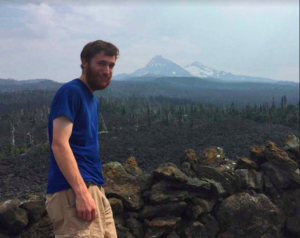By Andres Quevedo Contributing Writer

Bryce Neal conducted research over the summer at Yellow Stone National Park. (Photo Courtesy of Bryce Neal)
UMF Geology major Bryce Neal was a part of a research project in Yellowstone National Park during the summer of 2017, working alongside a research team based out of Oregon State University and the University of Wisconsin – Madison. They unraveled the volcanic secrets hidden underneath Yellowstone National Park.
Neal was chosen by the National Science Foundation Research Experience for Undergraduates (REU). REUs are summer programs that give undergraduate students majoring in STEM disciplines the opportunity to be involved with scientific research programs across the country.
The REU program took place from June 2017 to August 2017. For the first two weeks, students, including Neal, were in Oregon doing background research. Then, the students spent the entire month of July doing fieldwork in Yellowstone. After that, they came back to Oregon in early August to analyze their data.
This project involved geophysics, which he had been interested in before he applied for this program.
“You can think of it like taking an ultrasound of the planet,” Neal said.
Thanks to this research, new data has been added to the historiography of volcanic research. Using geophysics, Neal and the research team successfully imaged magma “bodies” at both shallow and deep portions of the Earth’s interior.
“When I say magma bodies, I don’t mean huge, completely liquid magma bodies that you might see in a science fiction film,” Neal said. “The magma bodies we imaged are only partially melted, meaning that they mostly consist of superhot rock and a little bit of magma here and there.”
Neal said, “I applied for the Earth Science REU program at Oregon State University in Corvallis, Oregon, and was accepted in March 2017. Originally, the research project I chose to be involved with was using geophysics to better understand earthquake risk in the Cascadia Subduction Zone.”
In late April, his research mentor notified him that the lab had received funding and a National Park Service research permit to conduct a major project in Yellowstone National Park. “My mentor asked me and my work partner Rebeca if we wanted to be part of the field team, and we both enthusiastically said yes!” said Neal.
The project involved utilizing a geophysical technique called magnetotellurics, which uses solar flares and global lighting activity to measure variations in electric and magnetic fields in the planet’s interior. This allowed the research team to determine how electrically conductive or resistive materials that make up the Earth are. Magma, water, and metals are very conductive, while bedrock is often very resistive.
Neal had displayed his skills in other research programs in the New England natural landscape before his fieldwork in Yellowstone. “During summer 2016, I worked with Dr. Julia Daly on her Maine Mountain Ponds project monitoring high elevation ponds in Maine and New Hampshire. Right now, I’m working with Dr. Douglas Reusch mapping the geology of Saddleback Wind in Carthage, near Mt. Blue State Park,” he said.
This research will undoubtedly contribute to Neal’s career and professional path.
“This research gave me a lot of experience with geophysics, which I would like to pursue in the future whether it be through employment or graduate school,” Neal said. “My coworker and I also got the opportunity to present this research at the 2017 American Geophysical Union Fall Meeting in December, which was an amazing experience.”